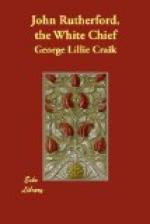These trees had attracted Cook’s attention in his first voyage, as likely to prove admirably adapted for masts, if the timber, which in its original state he considered rather too heavy for that purpose, could, like that of the European pitch-pine, be lightened by tapping; they would then, he says, be such masts as no country in Europe could produce. Crozet, however, asserts, in his account of Marion’s voyage that they found what he calls the cedar of New Zealand to weigh no heavier than the best Riga fir.
Nicholas brought some of the seeds of the New Zealand phormium with him to England in 1815; but unfortunately they lost their vegetative properties during the voyage. It appears, however, that, some years before, it had been brought to blossom, though imperfectly, in the neighbourhood of London; and in France it is said to have been cultivated in the open air with great success, by Freycinet and Faujas St. Fond. Under the culture of the former of these gentlemen it grew, in 1813, to the height of seven feet six lines, the stalk being three inches and four lines in circumference at the base, and two inches and a half, half-way up. Upon one stalk he had a hundred and nine flowers, of a greenish yellow colour; and he had made some very strong ropes from the leaves, from which he had obtained the flax by a very simple process.
According to Rutherford, the natives, after having cut it down, and brought it home green in bundles, in which state it is called “koradee,” scrape it with a large mussel-shell, and take the heart out of it, splitting it with the nails of their thumbs, which for that purpose they keep very long. It would seem, however, that the natives have made instruments for dressing this flax not very dissimilar from the tools of our own wool-combers. The outside they throw away, and the rest they spread out for several days in the sun to dry, which makes it as white as snow. In this prepared state it is, he says, called “mooka.” They spin it, he adds, in a double thread, with the hand on the thigh, and then work it into mats, also by the hand: three women may work on one mat at a time.
Nicholas, on one occasion, saw Duaterra’s head wife employed in weaving. The mat on which she was engaged was one of an open texture, and “she performed her work,” says the author, “with wooden pegs stuck in the ground at equal distances from each other, to which having tied the threads that formed the woof, she took up six threads with the two composing the warp, knotting them carefully together.” “It was astonishing,” he says, “with what dexterity and quickness she handled the threads, and how well executed was her performance.” He was assured that another mat which he saw, and which was woven with elaborate ingenuity and elegance, could not have been manufactured in less time than between two and three years.
Valuable, however, as is the phormium for the purposes to which alone it is applied in New Zealand, it would appear that the attempts which have been made to fabricate from it what is properly called cloth have not hitherto been attended with a favourable result. Some years ago, a quantity of hemp that had been manufactured from the plant at Sydney, was sent to be woven at Knaresborough; but “the trial,” it is stated, “did not succeed to the full satisfaction of the parties.”




